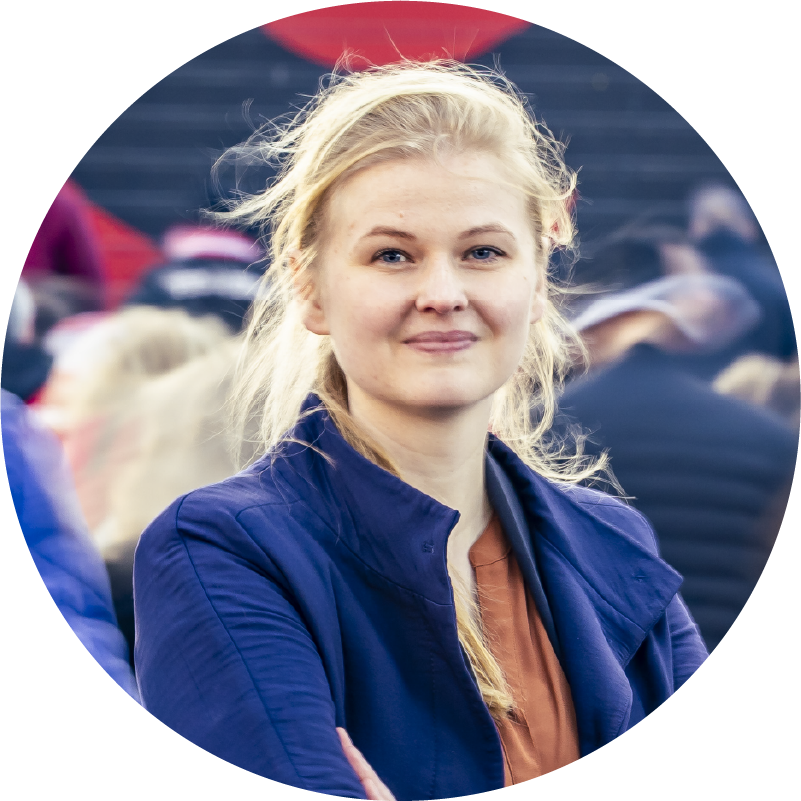When Fans Walk Safely
Vision for the Future – Safe!
The innovative research project CroMa-PRO aims to revolutionize crowd management at major events, starting with the UEFA European Championship.
June 2024
Vision for the Future Safe
Enhancing Safety at Major Events: The Goal of CroMa-PRO
At Fortuna Düsseldorf’s home games, the Merkur Spiel-Arena buzzes with eager football fans, all rallying behind their beloved team. But for Dr. Jette Schumann from the Institute for Civil Security Research at Forschungszentrum Jülich, the real intrigue lies in the lead-up to the match.
How do these passionate fans journey to the stadium? Which paths do they choose? And where in the city does congestion or excitement build? These are the questions that Dr. Schumann and her colleagues explore in the CroMa-PRO research project.
Their mission? To enhance the safety and enjoyment of large-scale events. “We employ computer models to simulate visitor flows,” explains Dr. Schumann. “This assists event organizers and security personnel in analyzing processes meticulously and preparing for seamless event execution.”

»Our goal is to ensure effective crowd management during major events.«
Dr. Jette Schumann
Researcher at CroMa-PRO
The “Last Mile” to the Stadium: Security Focus and Practical Tests at UEFA Euro 2024
The spotlight falls on the critical “last mile,” the pivotal stretch leading to the venue. “This area marks the transition from everyday pedestrians to event attendees,” says Jette Schumann. “It could be a parking lot or a subway station, from which fans continue their journey toward the event location.”
The first practical test for this project, funded by the German government with 1.4 million euros, is the UEFA European Championship. During the summer, the Merkur Spiel-Arena will host five matches in Düsseldorf, attracting not only Fortuna fans but also supporters from across Europe. CroMa-PRO will scientifically accompany these games.
CroMa: Crowd Management Grand Experiment in Düsseldorf
The CroMa-PRO project doesn’t operate in isolation. Researchers from Jülich collaborate with simulation experts from the German Aerospace Center (DLR) and two practical partners well-versed in mobility and security concepts: Eventbande GmbH and D.LIVE. But it doesn’t stop there—security services, fire departments, public transportation, and other relevant stakeholders are also actively involved. According to Jette Schumann, the uniqueness of this endeavour lies in its holistic approach: “For the first time, we’re examining a broader area around the event venue.”
From Evacuation Scenarios to Event Attendance: Simulating the Journey
The scientists delve into scenarios like fan walks. When thousands of people move as a cohesive group toward the arena, critical planning questions arise: How long does it take for the last fans to reach the stadium? How far does the crowd extend? And what about road closures or blocked railway crossings?
In their simulations, each football fan appears as an individual point on the screen. These “agents,” as Jette Schumann calls them, move based on their surroundings. “Those who can move freely typically maintain a certain speed. As we approach others or even a wall, our pace slows down. The models account for this.”
Using the number of people and the layout of the route, the computer calculates the crowd’s movement. “Existing models have primarily been used for evacuation scenarios. The dynamics during the journey to an event like the UEFA European Championship are undoubtedly different,” explains Schumann.
When the fans surge: A podcast with Jette Schumann

Dynamics and Special Features of Fanwalks: Insights and Challenges
In light of this, the researchers engaged in discussions with the relevant stakeholders to uncover the distinctive features of a fanwalk. They then incorporated this valuable information into their models. “For instance,” explains Jette Schumann with a hint of amusement, “we assume that the fanwalk moves at a more leisurely pace, and people maintain a slightly greater distance from one another.” Taking the next step, the team combines pedestrian simulations with urban traffic models, adding another layer of complexity.
The comprehensive examination of pedestrian behavior and traffic patterns aims to identify potential bottlenecks, issues, or risk areas during both arrival and departure. “Our insights,” Schumann notes, “provide planners with actionable recommendations.” For example, simulations suggest that, under certain assumptions, a significant portion of the fanwalk may still be waiting for entry an hour before the game begins. Timely processing? An impossible feat! Consequently, the fanwalk must kick off earlier.
The accuracy of these assumptions and models will be put to the test in June during the European Championship—an experiment that promises valuable insights, according to Schumann. Her vision for the future involves further refining simulation models, establishing them as indispensable tools for event planning. She firmly believes that simulations hold the key to answering critical safety-related questions.
Civil Security Research at Forschungszentrum Jülich
Next Steps and Upcoming Major Events
To achieve this vision, extensive research lies ahead. The CroMa-PRO team is already turning its attention to the next event—whether it’s a music festival or a public gathering. There, the scientists will need to account for entirely new intricacies in their simulations. However, one constant remains: Jette Schumann’s focus isn’t on what happens on the field but rather what unfolds before it.
Image: Martin Leclaire / Forschungszentrum Jülich
Editorial: SeitenPlan
Download the latest issue
In the realm where brilliant ideas from laboratories transform into tangible applications, our scientists redefine the boundaries of what’s possible.
Welcome to Endeavours Magazine, where we explore how FZ Jülich’s innovations shape a greener, smarter, and safer future.





